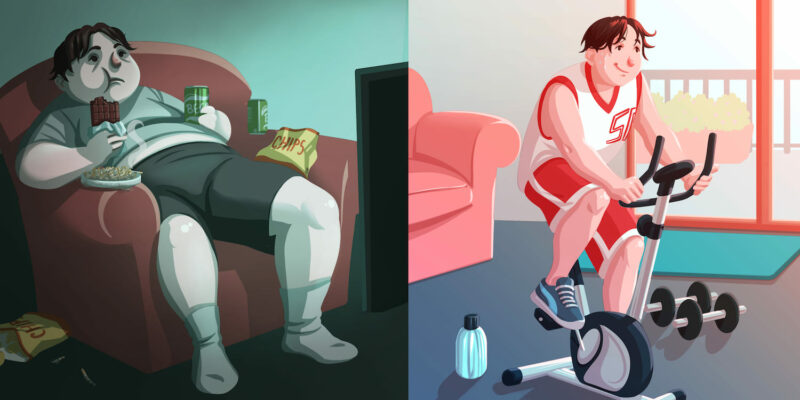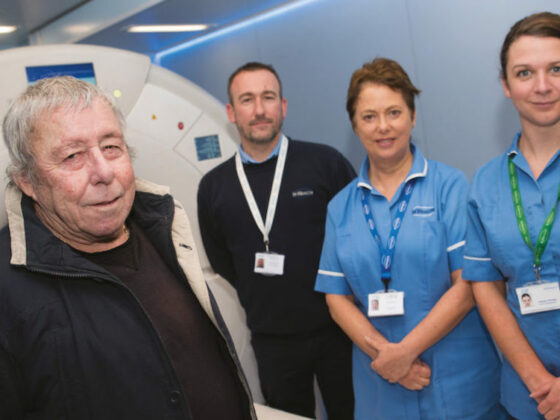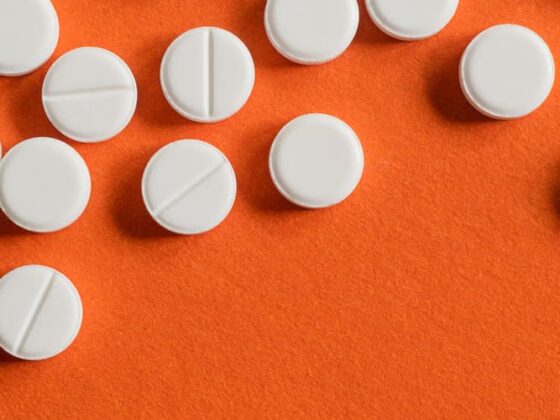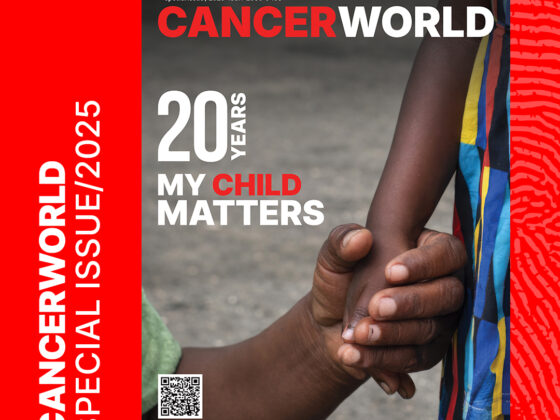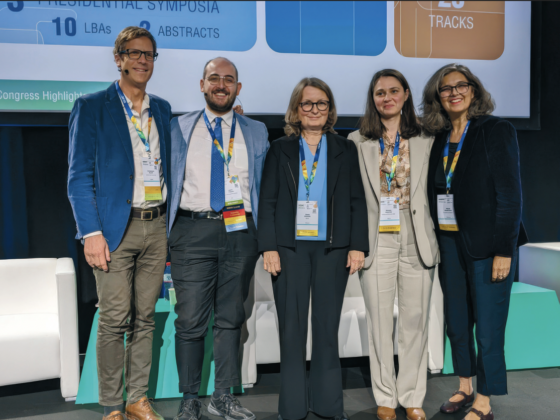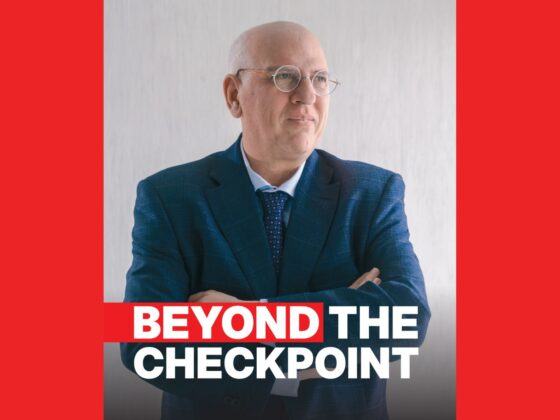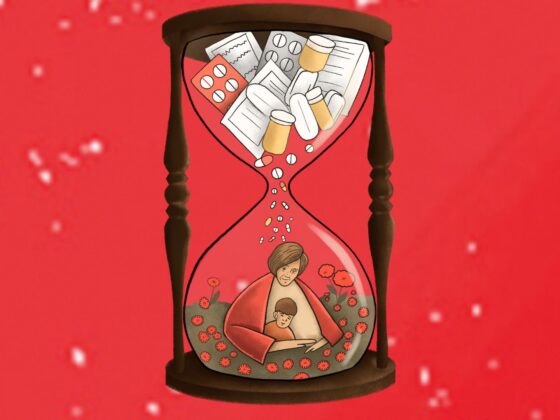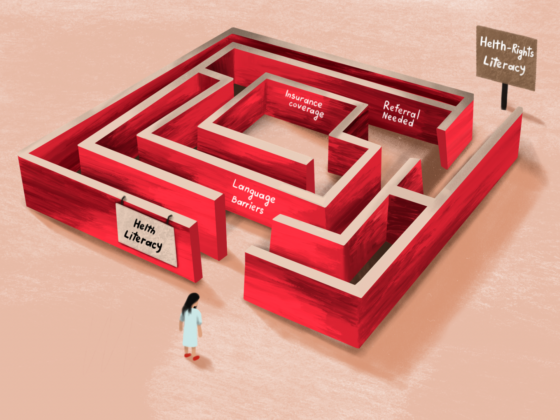The expression ‘couch potato’ conjures up images of a worldly-wise, self-mocking type who leaves the rat-race to others, while happily cuddling up in front of the TV with snacks and drinks. Yet the consequences of such a lifestyle are dire. Physical inactivity is one of the leading causes of preventable death worldwide, triggering or exacerbating conditions such as heart attack, stroke, hypertension, depression, obesity, osteoporosis, respiratory problems, type 2 diabetes, sleep apnoea, and many forms of cancer.
Physical activity has an important role in cancer prevention for various reasons. Biologically, exercise affects systemic functions that lower the risk of many types of cancer, e.g. insulin/glucose metabolism, immune function, inflammation, sex hormones (Rock CL et al CA Cancer J Clin 2020). Inhibiting cancer cell proliferation and inducing apoptosis and regulating metabolism and the immune environment are the main mechanisms of the benefits of physical exercise in cancer prevention and treatment (Wang Q et al. J Sport Health Sci 2021).
Its association with reduced risks of colon and breast cancer has been known for some time. In recent years, however, the range of cancers for which exercise regimes have shown to have a promising effect on prevention has been extended to more than 13 types, including the endometrial, bladder, oesophageal adenocarcinoma, kidney, and gastric. In association with diet, physical exercise helps to stay at a healthy weight. According to the European Association for the Study of Obesity, between 7% and 41% of certain cancer burdens are attributable to overweight and obesity. Exercising also has the inherent advantage of reducing sedentary time.
We humans are built to be active. But establishing the intensity, duration, and type of activity most effective to promote health is quite complicated. We often talk about exercise, physical activity, fitness, and sport as if they were interchangeable terms. They are not, though they can overlap or complement one another to result in the right level of exertion.
The WHO’s definition of ‘physical activity’ is “any bodily movement produced by skeletal muscles that requires energy expenditure”. In other words, any movement, from walking to gardening, cleaning, redecorating, etc. ‘Exercise’, on the other hand, is movement that is planned, structured, and repetitive. It builds and maintains physical fitness. The main components of fitness are aerobic endurance, muscular endurance, strength, and flexibility. Balance, power, speed, agility, body composition, coordination and reaction time are also maintained and improved through physical exercise. Sport shares most of the benefits of exercise, with the extra bonus of forming social relationships in the case of team sports. It is often of a competitive nature, however, which can potentially push participants beyond their limits.
Exercise induces a response from the body which works to maintain an appropriate level of homeostasis for the increased demand in physical, metabolic, respiratory, and cardiovascular effort. Time, consistency, and progression are fundamental to ‘convince’ the body that it needs to adapt to increased demand. Paradoxically, someone can be both sedentary and active, for instance, if after a day at their desk they cycle or go to gym classes, while a bartender can be non-sedentary, yet physically inactive, if after a day standing on their feet they go home and rest until the following day.
The history of exercise and health
“Exercise is a voluntary movement that induces deep, frequent breathing. Its proper, moderate use prevents physical illnesses.” This quote could come from any contemporary health publication. In fact it comes from Ibn Sina, commonly known in the West as Avicenna, a Persian polymath who lived at the dawn of the first millennium, and wrote more than four hundred books, including at least 40 medical texts, drawing from the knowledge of Indian and Persian medicine, in addition to the Greek and Roman medical literature.
It is uncertain when the association between physical exercise and preventing illness was first made. Evidence of competitive and leisure activities such as swimming, dancing and ball games dates back many thousands of years. Yoga has been around for at least 5,000 years. Our remote and more recent ancestors built muscle tone, endurance, flexibility, and stealth through physical training and war-related games, such as running, fighting, marching, jumping and javelin throwing. The purpose of training could be military, competitive, recreational, or even aesthetic, as in achieving a well-sculpted body. Physical training was usually the domain of a dedicated instructor, not a medical doctor.
The first physician known to prescribe physical exercise for health was not, as is often assumed, Hippocrates, who lived in the 4th century BCE and is known as the ‘father of medicine’. It was Sushruta, an Indian doctor and surgeon, believed to have lived during the 6th century BCE. In his vast compendium, the Sushruta Samhita, he repeatedly advocates moderate exercise to maintain or re-establish health, seen as a balance of humours. Because needs vary according to personal history, condition and circumstances, exercise needs be tailored accordingly. Excessive exhaustion is counterproductive.
Hippocrates believed that a good physician must balance the prescription of exercise based on the patient’s condition, food intake, body mass, age and environment
In Greece, Hippocrates was a strong promoter of ‘regimen’, that is, of combining diet and exercise for health. “Eating alone”, he wrote, “will not keep a man well, he must also take exercise, because food and exercise, while possessing opposite qualities, yet work together to produce health” (On Regimen I.ii. 22). On similar lines to Sushruta, Hippocrates believed that a good physician must balance the prescription of exercise based on the patient’s condition, food intake, body mass, age, environment and so on.
As the study of medicine was not canonised in Ancient Greece, there were many schools of thought among physicians, and much bickering and slander, but overall, the focus was similar: prevention, in the form of diet, exercise and hygiene, was favoured over cure, and cure over surgery ‒ not surprisingly, perhaps, when we think of the ‘heroic’ nature of some of the treatments.
But it was Galen in the 1st century CE who exercised the most lasting influence on Western medicine. His theory of what became known as the ‘non-naturals’ survived in European medical thought for nearly fifteen centuries. The ‘non-naturals’ referred to things that are not innate, but over which humans could and should have control: air, food and drink, rest and exercise, sleep and waking, excretions and retentions, and emotional affections. Galen also saw exercise as vital to well-being, but he stressed the need for moderation in the intensity and duration ‒ do enough, but do not overdo it.
The meaning of moderation ‒ then and now
Herodicus was a Greek physician in the 5th century who, even before Hippocrates, stressed the importance of exercise for health. If we are to believe Plato (who was apparently not a great fan), Herodicus’ idea of moderate exercise was walking from Athens to Megara and back ‒ a trek of about 20 miles. “Herodicus, being a trainer, and himself of a sickly constitution, by a combination of training and doctoring found a way of torturing first and chiefly himself, and secondly the rest of the world,” (Plato’s Republic III, 406). Aristotle was not that impressed either: “Bodily excellence is health, and of such a kind that when exercising the body, we are free from sickness; for many are healthy in the way Herodicus is said to have been, whom no one would consider happy in the matter of health, because they are obliged to abstain from all or nearly all human enjoyments,” (Aristotle, Rhetoric, book 1, chapter 5). In his treatise The Exercise with the Small Ball, Galen recommends the small ball as the best form of exercise for health, as it is a total workout, it is portable, and its intensity can be adapted as required. If the small ball is to be identified with the harpastum, it was a game similar to rugby… not exactly the gentlest of activities.
From the 17th century, when major discoveries in the field of medical science brought the development of drugs and treatments that were progressively more efficient and less invasive, scientific interest shifted from prevention to cure, and exercise gradually reverted to the domain of trainers and physical education instructors. The focus also became more on sports and less on moderate exercise. The ever-increasing speed of technological development in the 20th and 21st centuries progressively lifted the ‘burden’ of physical exertion, reducing the need for movement, and sowing the seeds of the ‘couch potato pandemic’. With chronic non-communicable diseases now topping the mortality charts, the medical community is rediscovering the need to focus more on prevention, balance, moderate diet and exercise.
To promote healthy changes in our bodies (and minds) we need to do regular physical exercise, with quantifiable intensity and duration. Because the results are not immediate and the activities are not necessarily that gratifying or interesting per se, adherence is an issue. The good intentions are there, but discouragement sets in quickly, especially if exercise is seen as something we are obliged to do, rather than a pleasurable activity. Attendance at the gym typically falls dramatically after the first few months, and those who drop out earliest are often the ones who most need to improve their fitness. In a gym, exercise class, or outdoor structured physical activity, individuals with low levels of fitness might feel physical and mental discomfort, due to early onset of breathlessness, fatigue, fear of failure, and body image issues. Introduction to healthier lifestyles need be gradual and individually tailored.
To test, prescribe and evaluate exercise, a unit of energy expenditure was agreed upon ‒ the metabolic equivalent of task (MET) ‒ which, despite limitations, provides a useful and versatile way to measure activity intensity. 1 MET is defined as the energy expended by a subject at rest (resting metabolic rate, RMR) and is roughly equal to 1 kilocalorie per kilogram of body weight per hour. There are standard parameters of recommended intensity available, and charts calculating the energy expenditures of everything from walking to surfing, painting walls, and mowing lawns. This allows for a move away from a ‘one size fits all’ definition of ‘moderate exercise’ towards tailoring of physical activity regimes that take into account an individual’s condition, environment, interests and needs.
From guidelines to personalised exercise interventions
The benefits of physical exercise are not limited to prevention. Its critical contribution to the treatment of diseases has been known for a long time: it improves cardiovascular and respiratory efficiency, muscular strength, balance, reflexes, and so on. It also reduces fatigue, depression, and low self-esteem. Yet, until recently, the value of physical activity in people living with and beyond cancer was poorly investigated. One reason could be that cancer used to be associated with poor outcomes, and it was deemed unlikely that patients who were undergoing or had completed intensive treatments, would be able to engage in an exercise routine. The usual medical advice was to rest and avoid strenuous activity. Some clinicians may still be giving that advice today.
Exercise may reduce the risk of cancer mortality and recurrence, as it helps counteract some treatment side effects, improving treatment completion rates
But now the scenario has changed drastically, due to the progress made in cancer research, early detection, and newer treatments. According to the Cancer Atlas, in 2018 there were almost 44 million cancer survivors diagnosed within the previous five years. Together with the increase in survival rates and longer life expectancy, the field of exercise oncology has also grown. There is now strong evidence that exercise provides benefits in quality of life and muscular and aerobic fitness for those living with and beyond cancer. It may also reduce the risk of cancer mortality and recurrence, as it helps to counteract some side effects of treatment, such as cardiotoxicity, and can reduce the sensation of fatigue and nausea, thus allowing for higher treatment completion rates. Furthermore, improved fitness has been associated with better surgical outcomes, and less complications and morbidity. Exercise may contribute to reducing inflammation and to building a stronger immune system. It is also believed to have a role in preventing metastases, as it alters the microenvironments in the body where metastatic cancer cells may be dormant.
It is now widely recommended that cancer survivors avoid inactivity and engage in regular exercise. Several cancer and sports organisations have endorsed exercise guidelines, including the American Cancer Society, the National Comprehensive Cancer Network, the American Society of Clinical Oncology, the European Society for Medical Oncology (ESMO), the American College of Sports Medicine, Exercise and Sports Science Australia, and the British Association of Sport and Exercise Science. However, these guidelines tend to be rather generic, such as those published in the ESMO Handbook on Rehabilitation Issues During Cancer Treatment and Follow-Up, which say, “Adult cancer survivors are advised to engage in either at least 150 minutes per week of moderate intensity or 75 minutes per week of vigorous intensity aerobic physical activity, or an equivalent combination of both. Muscle-strengthening activities involving all major muscle groups are recommended at least two sessions per week.”
More research is needed to develop physical activity programmes that work best for different types and grades of cancer. These should also take into account the effects of the different treatments undertaken, and differences in patients’ medical history, circumstances, and personal tastes. They would also need to address the many obstacles to widespread and sustained adherence. A recent paper published in BMC Cancer highlighted the need for robust measurement and reporting of implementation outcomes to help to identify what strategies are essential for successful implementation of exercise interventions.
Thankfully, the days of compulsory Lycra fitness gear and aerobic exhaustion have been largely consigned to history, along with prescriptions to walk from Athens to Megara. We can all do something to become fitter and healthier. Even the act of standing up as often as possible from a resting position on a couch or chair makes a difference.
The correlation between physical exercise and carcinogenesis is still too often overlooked by oncology teams and other health professionals
Fitness professionals need to be acquainted with the patient’s condition, symptoms, and side effects of treatments, to evaluate exercise tolerance and prescribe a safe and effective exercise programme. But the most important change has to start within the medical community. The correlation between physical exercise and carcinogenesis is still too often overlooked by oncology teams and other health professionals, with the result that exercise interventions are not routinely provided to people who have been diagnosed with cancer. This is particularly the case in advanced cancer settings, but it also holds true in early cancer settings where there may be opportunities to help prevent secondary neoplasms, and also in the wider setting of cancer prevention.
Physicians should give greater priority to encouraging people, and specifically cancer patients and survivors, to be active, test their fitness levels, and help them build, or refer them to, exercise programmes, possibly also combined with dietary advice.
Making a difference at a societal level, however, will require public, private, and community organisations to work together to create structures, initiatives, and environmental changes to provide safe, enjoyable, and accessible opportunities for physical activity for everyone, regardless of economic and social condition.
With the contribution of Francesca Albini, PhD
Illustration by Alessandra Superina

